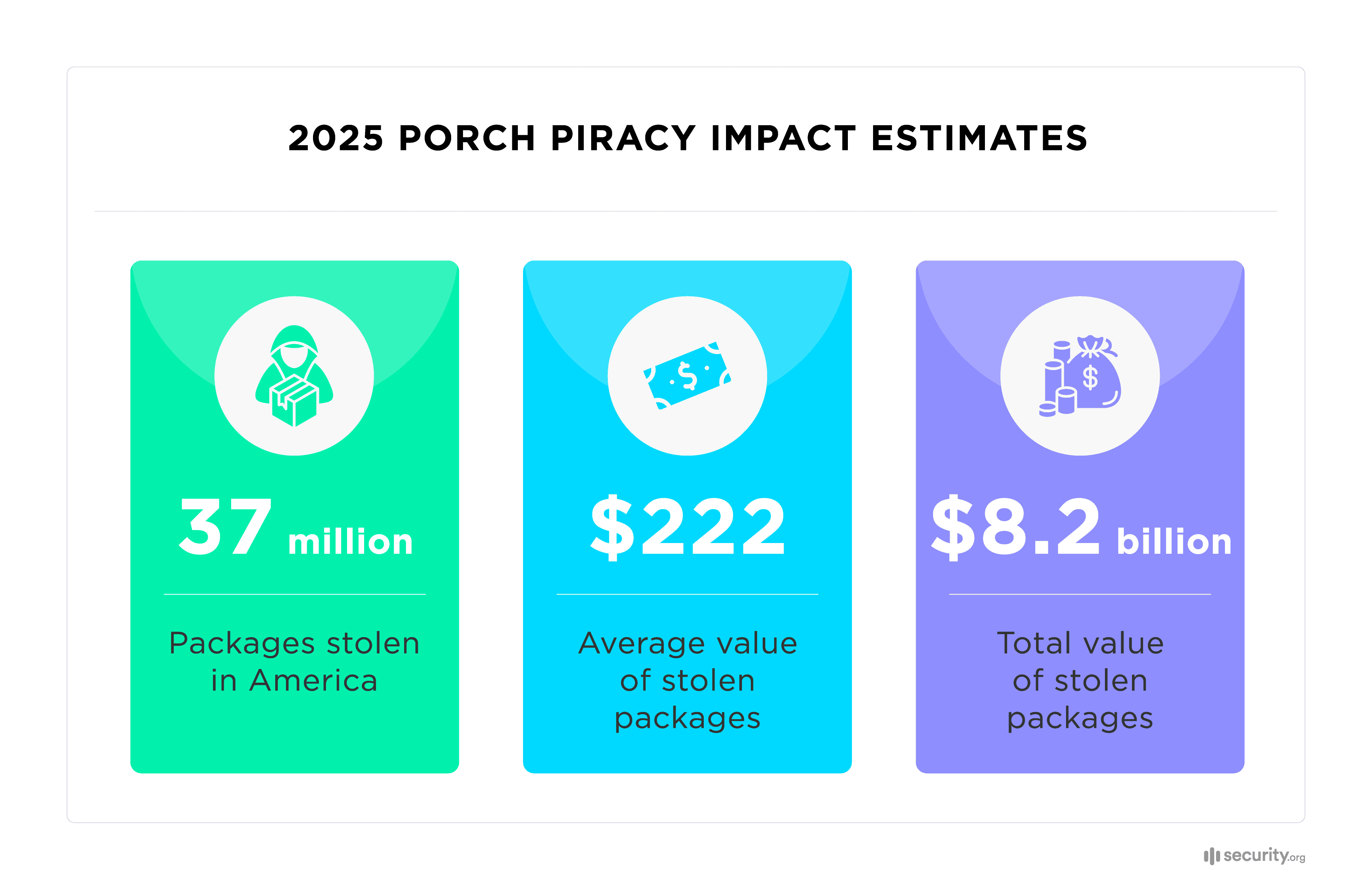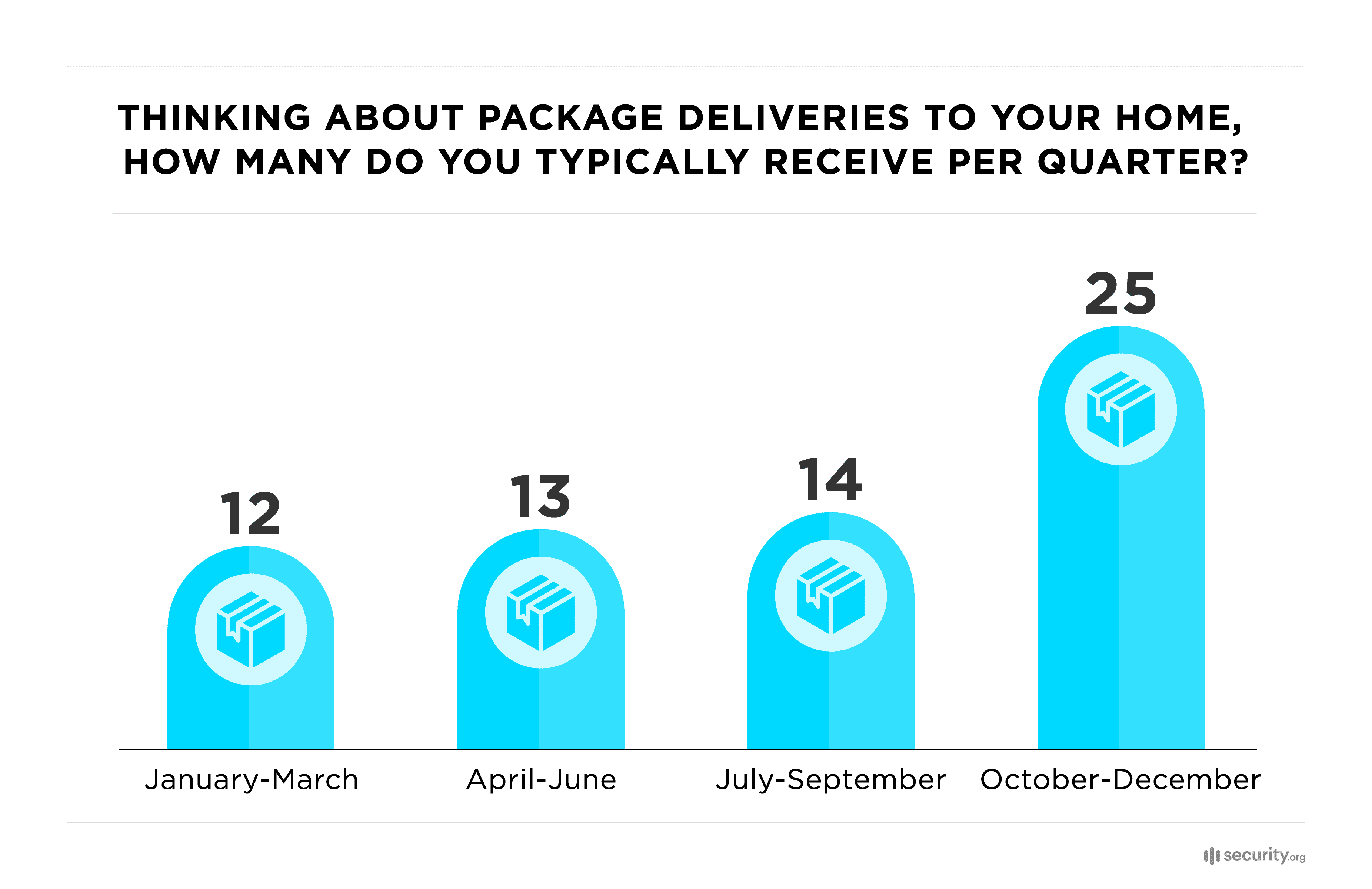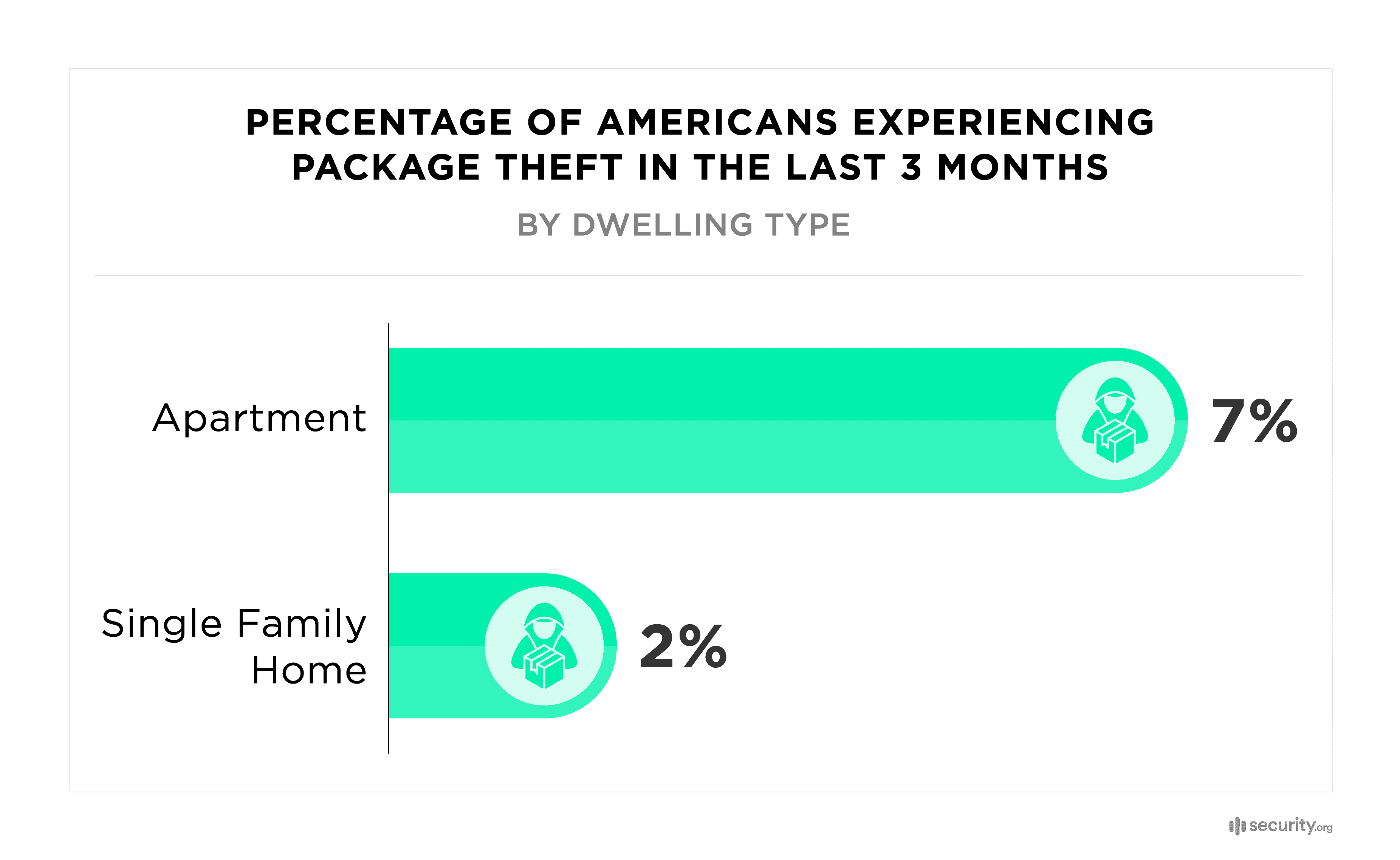2025 Package Theft Report and Statistics
31 Million Americans Have Had Holiday Gifts Stolen—Here's How to Keep Your Packages Safe This Season
Key Findings
- One in four Americans (or 64 million people) has had a package stolen at some point, and 9 million adults have had a package stolen in just the last three months.
- Package thieves stole $8.2 billion worth of online orders over the past year, with each stolen package worth about $222 on average.
- People living in apartments and condos are more than three times as likely to have packages stolen as people in single-family homes.
- Kentucky, North Dakota, Nebraska, Iowa, and Alaska had the highest rates of package theft.
- Fewer than 1 in 4 package theft victims reported the crime to local law enforcement, but experts recommend making police reports for all stolen packages, regardless of their value.
- More than half of homes now use at least one security device to protect their deliveries.
Americans love shopping online, and this year will end with more than $250 billion in online holiday sales. That’s excellent news for shoppers who don’t have to fight crowds at the mall—but it’s also great news for package thieves.
These gift-stealing Grinches will snatch millions of packages worth billions of dollars as Christmas and Hanukkah get closer. Even though new technology has made it easier to protect deliveries, most Americans still worry while waiting for their purchases to arrive.
We’ve been tracking package theft for over five years, and this year we surveyed more than 3,300 Americans about their online shopping habits, experiences with stolen packages, and what they’re doing to keep their deliveries safe. We’ve also put together expert tips to make sure your gifts don’t end up in the wrong hands this holiday season.
Expert Security Tip : From Gene Petrino, former S.W.A.T. commander and police sergeant
“My number one package theft tip is to eliminate opportunity. Thieves can’t steal what they can’t see. Have packages delivered to a secure location—like an Amazon Locker, UPS Access Point, or your workplace—or schedule deliveries for times when someone is home. Visible security cameras and motion lighting help, but the most effective deterrent is removing the target altogether.”
Online Shopping: How Much Do We Really Trust Deliveries?
Online shopping used to be a fun convenience, but now it’s something Americans truly depend on. We found that the average adult receives 65 shipments yearly, which amounts to more than 22 billion deliveries across the country annually.
Unfortunately, many of those packages never reach the people who ordered them. This year’s survey found that one in four Americans has had a package stolen at least once in their lives, and three percent have had one stolen in just the last three months.
The slightly good news? The number of people who’ve had packages stolen dropped a bit from 2024. The not-so-good news? The average value of a stolen package jumped nearly 10 percent over the past year (this could be because of inflation, tariffs, or thieves getting smarter about stealing pricier packages).
When we look at total delivery numbers, theft rates, and average package values, we estimate that 37 million packages will be stolen this year, totaling more than $8 billion in merchandise.
Package thefts increase when people turn to the internet to buy gifts at the end of the year. Our survey found that nearly 70 percent of 2025 holiday shopping will happen online, with each adult expecting 25 packages between October and December (twice as many as in the average 3-month period).
This flood of deliveries and their potential to be stolen makes online holiday shoppers nervous. Overall, 62 percent of online shoppers feel anxious while waiting for packages to arrive, with nearly one-quarter reporting “moderate” to “severe” anxiety that a package will be stolen. The most nervous people admitted to checking tracking info an average of eight times daily!
| How anxious do you feel while waiting for deliveries to arrive? | Percent of respondents | Average number of times respondents check package tracking during shipment |
|---|---|---|
| Not at all | 38% | 2 |
| Slightly | 39% | 3 |
| Moderately | 15% | 4 |
| Very | 6% | 6 |
| Extremely | 2% | 8 |
Most people also worry more about package theft during the holidays. That worry makes sense: 12 percent of shoppers—31 million Americans—have had at least one gift for someone else stolen by a porch pirate.
Here’s some good news from this year’s survey: online shoppers who are “highly concerned” about holiday package theft have dropped since our last report, from 28 percent to 18 percent.
Let’s look at what’s helping people feel more confident about their deliveries.
How to Stop Porch Pirates: High-Tech and Low-Tech Solutions
As online shopping has grown into a trillion-dollar industry, ways to protect deliveries have also improved. Simple approaches like requiring signatures or sending packages to work still work well. Still, artificial intelligence and smart home devices have given us even more options for monitoring deliveries remotely.
Eighty-eight percent of online shoppers use at least one strategy to prevent package theft, but 33 million Americans’ deliveries remain unprotected. Here are some steps they should consider to ensure their packages are secure.
High-Tech Protection
Forty percent of online shoppers use smartphone apps to keep their packages safe, and tracking apps are the most popular choice. These apps often give you real-time updates, so you can follow your package on a map, know exactly when it arrives, and see photos showing where it was dropped off.
A smaller (but growing) number of Americans are using neighborhood safety apps. These platforms (like Ring Neighbors and Nextdoor) bring together information from the community and can use AI tools to watch for and report local problems, spot patterns, predict potential threats, and alert law enforcement or delivery companies when they notice suspicious activity.
| Strategies used to prevent package theft | Percentage of respondents |
|---|---|
| Schedule shipments for when I am home | 46% |
| Doorbell camera | 34% |
| Outdoor security camera with motion detection or AI features | 28% |
| Shop in-store or online with in-store pickup | 26% |
| Have neighbors bring packages inside when I’m not home | 17% |
| Smart lighting or motion-activated lights | 17% |
| Have packages shipped to somewhere else besides the home (such as an access point) | 14% |
| Have packages delivered to someone else | 9% |
| Security alarm system (not connected to delivery alerts/cameras) | 8% |
| Leave work during breaks to bring deliveries inside at home | 7% |
| Smart lock or smart entry system | 5% |
| A service that delivers inside the home, such as Amazon Key | 3% |
| None of the above | 12% |
Note: Multiple responses allowed
Most Americans now use at least one security device to help protect their packages. Smart doorbells are in more than one-third of homes, making them the most common tool for this. Other popular options include outdoor security cameras, smart lighting, and alarm systems.
These security setups can scare off porch pirates, catch them stealing packages, or let you unlock your door remotely (even with a temporary code) so packages can be put inside when you’re not home. These tools also help people worry less: people who own one or more security devices report 40 percent less anxiety about package theft.
Remember that as security systems improve, criminals get smarter, too. In recent years, we’ve seen reports of organized theft rings with very clever tactics. Some use electronic scramblers to mess with security camera signals, follow delivery trucks and wear fake uniforms to pick up freshly delivered packages, and some hack into delivery companies or bribe shipping workers to find out which packages are especially valuable.
Non-Tech Protection
If you don’t have security devices protecting your home, the best thing to do is schedule deliveries for when someone will be there, or choose a different location where someone can watch your packages.
About half try to schedule deliveries for when they’re home, and one-quarter choose to pick up online purchases at actual stores. Others ask neighbors to bring in their boxes or have packages sent to safer places (like work or delivery lockers).
Who’s Most at Risk of Package Theft?
Package theft rates usually change based on where you live, how many people live nearby, and what type of home you have.
Package theft rates tend to be higher in rural areas, where security is often looser and fewer people are around to see crimes happen. However, the total number of thefts is much higher in cities, where hitting a single apartment building can mean lots of packages to steal. Also, people in apartment buildings (especially ones without a mailroom or doorman) are much more likely to be victims than people in single-family homes.
In fact, we found that apartment residents were victimized 3.5 times more often than homeowners in the most recent three-month period.
This unequal targeting also means more worry: people living in apartments are 1.5 times more likely to worry about stolen holiday gifts and feel anxious while waiting for deliveries.
Because people of color are more likely to be renters (often in apartments), worries about porch pirates also reveal racial differences. People of color are twice as worried about holiday deliveries being stolen as white respondents, and have been package theft victims twice as often as white people in the last three months.
Package theft rates also change depending on which state you live in. In 2024, these states had the highest and lowest rates of porch piracy.
| States with the most package theft | Percent who had a package stolen in the previous three months | States with the least package theft | Percent who had a package stolen in the last three months |
|---|---|---|---|
| Kentucky | 12% | Connecticut | 1% |
| North Dakota | 11% | Michigan | 1% |
| Nebraska | 10% | Utah | 1% |
| Iowa | 10% | Georgia | 2% |
| Alaska | 10% | New Jersey | 2% |
The five states most affected by package theft are mostly rural, while four of the five states with the lowest theft rates are among the 20 most crowded. Looking at regions, the West and the Northeast have the most packages stolen, while the Midwest is the safest area for packages.
Looking at these factors, the best place for package safety would be a single-family home in a suburban Michigan town. Since that’s an unrealistic prevention tactic for most Americans, let’s talk about what to do if a package goes missing.
What to Do if You’re a Victim of Package Theft
Even with careful planning, safe delivery spots, and modern home security, anyone can become a victim of porch piracy. If you have a missing package, act fast to confirm whether it’s been stolen, then quickly report it to retailers, police, and community groups if a crime has happened.
Experts recommend taking these steps when you can’t find a delivery:
Verify the package is missing: Take a deep breath and check its status before you assume it was stolen. Look at online tracking, check the delivery area for notes, or contact the seller or shipper directly. If a package shows as delivered, ask anyone who might have grabbed it for you (family, roommate, neighbor, doorman). If you figure out a package was stolen, look at security footage, check neighborhood apps, and contact the police to see if others have been affected too.
Tell the seller: Asking the store for a replacement is usually the fastest next step (especially if you’re trying to replace gifts before the holidays). Even though some online stores are getting stricter about returns and replacements, most will quickly send out a new item without much hassle. If the website doesn’t have an easy link to report missing deliveries, ensure you have all the important information (order number, tracking details, delivery date) before contacting customer support.
Report the crime to police: Fewer than one in four victims contact police, but filing a report with police can stop future thefts in your area. Gene Petrino, a former law enforcement and SWAT commander, strongly encourages reporting. “Even if the dollar amount seems small, these incidents help law enforcement identify crime trends and potential repeat offenders in specific neighborhoods,” he explains. “Package theft is often part of a larger pattern, and reports build the data needed for targeted patrols and prevention. Without those reports, police can’t see the whole picture or allocate resources effectively.”
Look into insurance: If the store or shipper doesn’t want to replace or refund your item right away, check your home insurance policy to see if it covers theft (and what your deductible is). Also, contact your credit card company to stop payment on the product or use purchase protection.
| Where did you report your most recently stolen package? | Percentage of theft victims |
|---|---|
| The store/company it was purchased from | 64% |
| The delivery company (i.e., UPS, USPS, or FedEx) | 62% |
| Police/Law enforcement | 23% |
| Online neighborhood group or message board | 23% |
| Social media | 23% |
| Doorbell camera providers, such as the Amazon Ring app | 9% |
| None of the above | 4% |
Note: Multiple responses allowed
Nearly all porch pirate victims (96 percent) reported the theft to some company, group, or organization. Almost two-thirds told the store or shipper, while less than a quarter contacted police or community groups.
It’s even better to know how to prevent a crime before it happens than to know what to do after. Keep reading for tips on keeping your deliveries safe.
Tips for Protecting Packages and Holiday Presents
The internet is full of expert advice and AI tools designed to fight porch pirates. Tips range from common-sense habits to cutting-edge technology. Still, they all come down to three things: making your home secure, quickly getting packages inside, and avoiding leaving packages outside in the first place.
Secure your home: If you want packages delivered, there are many ways to protect your property. Using technology is the best way to manage security when you’re away, since smart devices let you monitor and control things remotely from anywhere with an internet connection. Video doorbells, smart locks, security cameras, and motion-activated lights scare off trespassers and let you manage your delivery area from anywhere. Also, make sure people can see you have security systems—scaring off pirates is better than catching them in the act.
Get packages inside quickly: Every minute your packages sit outside increases the chance they’ll be stolen. Former law enforcement officer Gene Petrino said, “My number one tip is to eliminate opportunity. Thieves can’t steal what they can’t see. Visible security cameras and motion lighting help,” Petrino says, “but the most effective deterrent is removing the target altogether.”
Ship packages to the safest location: Everyone loves coming home to a package they’ve been waiting for, but giving up a little convenience for better security is worth it if it means not getting robbed. For example, having packages sent to available friends, family, or neighbors means packages will never sit on the street. Shipping packages to your workplace means they will not be left unattended. Use delivery lockers where packages are protected, and you can pick them up anytime.
Shop online and pick up in store: When you find online deals with a physical store (like Walmart or Target) or platforms with partners (like Amazon with Whole Foods), you can buy with a click and pick up items in person—maybe even with quick curbside pickup. Look into your options. Package theft costs retailers billions annually, so they’re happy to help you find the safest way to shop online.
Methodology
In October 2025, Security.org polled 3,307 American adults about their personal experiences with package theft. The poll was conducted online. Participants’ responses were weighted to be representative of the age, sex, and ethnicity of the U.S. population according to the Census.
Sixty-eight percent of respondents live in single-family detached homes, 26% reside in apartments or condominiums, and the remaining 6% report other living arrangements such as duplexes, townhouses, RVs, or communal housing (e.g., nursing homes).
Participants who’d had a package stolen in the last three months were asked to report the approximate value of their most recently stolen shipment. We estimated the number and value of packages stolen in the last three months by multiplying the U.S. adult population by the incidence of package thefts in our survey. To determine the cumulative value of packages stolen in the past 12 months, analysts multiplied the packages stolen in a three-month time period by four.




